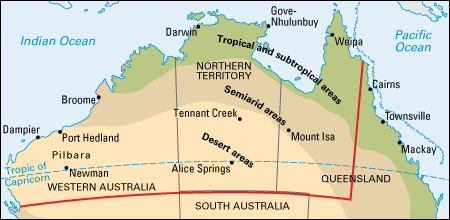Northern development in Australia includes all land north of the South Australian border except for the sugar coast of Queensland. The region occupies 54 percent of the area of Australia. But its population of 415,000 is only about 2 percent of the Australian total.

The region has few resources for developing agriculture. Nearly three-quarters of it is desert or semidesert. In such lands, carefully managed stock-grazing on large properties is the only practical form of farming.
The monsoon climate means that there is an annual drought of from 6 to 10 months in all parts of the development. Even in those regions that receive more than 24 inches (61 centimeters) of rain a year, only special crops that mature quickly can be grown. Otherwise, farmers must use irrigation. The region does, however, contain extensive mineral resources.
In the 80 years before World War II ended in 1945, development of northern Australia had been extremely slow. It consisted mainly of extensive beef-cattle grazing, plus a few scattered mining centers. The threat of invasion by the Japanese during World War II gave rise to a demand by many Australians to improve road and air transport in the area and to develop these vast empty lands. The development would improve security and make the region easier to defend.
A number of farmers attempted large crop-farming ventures in northern Australia in the 1960’s and 1970’s. However, all of these attempts failed. During the 1960’s and early 1970’s, the discovery and development of several huge, rich mineral deposits in the northern region changed the pattern of development dramatically. These mineral deposits include iron ore in the Pilbara District and bauxite at Weipa and Gove. See also Northern Territory; Western Australia.
